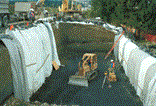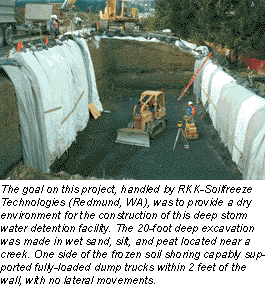Frozen ground serves as shoring for a number of applications

Engineers at the recent ASCE meeting learned that ground freezing can be used in a number of applications including shoring, containment and removal of contaminates.
By Joyce Everhart
Managing Editor, Public Works Online
jeverhart@vertical.net
Although the technology has been around for more than a century, it has only been in the last decade or so that ground freezing for shoring, containment or removal of contaminates has become more cost effective and, therefore, more commonplace.
Walls of frozen soil can isolate contamination
Walls of frozen soil, which can merely be unplugged and melted away, are taking the place of steel supports and shoring in some instances. Contaminated areas are being isolated with barriers of ice customized to fit whatever configuration required. And entire blocks of frozen, contaminated soil are being raised from the ground and carried away.

Frozen soil has strength of concrete
Because it is nearly the strength of concrete and impermeable, frozen soil shoring is quickly becoming the selected choice in below-ground construction where groundwater or contamination is a problem.
It has been used in projects as large as the Boston Tunnel or as small as the repair of a sewer outfall.
With these trends in mind, engineers and public works officials gathered at an education session at this year's American Society of Civil Engineers Annual Conference in Seattle, WA, to hear the latest techniques and projects involving ground freezing.
Pipes with refrigerant are inserted in ground
Basically, the technique involves locating mobile refrigeration systems near the construction site, inserting closed-end pipes into the ground and circulating a refrigerant—usually brine—through them to slowly freeze the surrounding soil. The process accomplishes the task within a period of several months. John Donohue with Moretrench American Corporation (Rockaway, NJ) explained that after the first three weeks, the soil around the pipes begins to freeze. After six weeks "closure" occurs whereby the soil surrounding each pipe begins to merge with nearby pipes. By the end of 12 weeks, a frozen wall has developed that is solid enough to serve as shoring for an excavation, or as a wall blocking ground water or contamination.
The advantages of such a process is that it:
- Effectively cuts off groundwater, which can eliminate dewatering and/or concrete seals for many projects.
- Works in the most difficult types of soil and groundwater conditions including running sand, clay, peat, cobbles, gravel or bedrock.
- Makes very low vibrations and noise during installation.
- Is easily installed around and below existing buried utilities, which allows for continued use of the utilities.
- Can be completely removed following construction returning the site to pre-constuction conditions after the soil is thawed.
- Is less affected by power outages than dewatering since it can remain stable for weeks without power.
Two other speakers discussing the merits of ground freezing included Bernd Braun, a geotechnical consultant (Coppell, TX) known for his work with shafts, and Dan Mageau with GeoEngineers, Inc. (Redmund, WA), who specializes in ground freezing applications for contaminated sites.
A question of safety arose from audience
Questions from the audience included one concern about the safety. It was explained that tests were done to test the temperature of the soil, which can go as low as -31°F. It was also noted that this procedure has been done in tunnels under railroads with trains on them. A frozen arch supported the weight of the trains.
Since a leakage of brine would cause the soil to thaw, the brine level are carefully monitored. One technique to make certain the pipes were still frozen is to allow a "snowball" to collect on the top of each pipe inserted in the ground so that a visual monitoring can be done.
Takes a long time to freeze, a long time to thaw
Another question was raised concerning what would happen if there were a power failure. The audience learned that the actual thawing takes a long time. "It takes a long time to freeze and a long time to thaw," one presenter said. He illustrated his point relating an incident when the power was shut off. The temperature of the soil went from -10° to -7° in three weeks.
